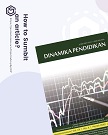Development Strategy of Lanting Small Industry
(1) Universitas Negeri Semarang
(2) Universitas Negeri Semarang
Abstract
This research aims to describe and analyze the strategy of production, marketing, human resources (labor), and capital. The technique of collecting data used observation, interviews, documentation, questionnaires, and triangulation. The technique of sampling was purposive sampling. Findings show that the strategy of production, marketing strategies by the way of increased order coupled with the trademark shows as well as various flavors of innovation development, adjustment of the selling price with the price of raw materials production, the cooperation of manufacturers and suppliers in the distribution of lanting, promotional activities by means of cooperation with the agency and related service trade off products online. The strategy of human resources is with the formation groups of industry in the village of Lemahduwur (but not running smoothly). Strategy capital with the initial capital comes from its own capital and profit as capital accumulation, additional capital when many party and by feast day; increased access to capital, financial administration and against accounting in a simple and routine. The advice given is the government and manufacturers improve HR, technology development, marketing and capital. Manufacturer improves collaboration with suppliers of raw materials, maintaining the typical features and making a trademark.
Keywords
Full Text:
PDFReferences
Anoraga, P. (2000). Manajemen Bisnis. Jakarta: Rineka Cipta.
Anoraga, P. (2011). Pengantar Bisnis: Pengelolaan dalam Era Globalisasi. Jakarta: Rineka Cipta.
Anoraga, P. & Sudantoko, D. (2002). Koperasi, Kewirausahaan, dan Usaha Kecil. Jakarta: PT Rineka Cipta
Gupta, S. (2012). Interdependence between experience marketing and business strategy. Journal of Indian Business Research, 4(3), 170-193.
Kuncoro, M. (2007). Ekonomika Industri Indonesia, Menuju Negara Industri Baru 2030?. Yogyakarta: Andi Offset.
March, I. C., & Gunasekaran, A. (1999). Business strategy in new high-tech ventures: an empirical analysis. Management Decision, 37(3), 222-232.
Prawirosentono, S. (2007). Pengantar Bisnis Modern Studi Kasus Indonesia dan Analisis Kuantitatif. Jakarta: PT Bumi Aksara.
Rahmana, A. Iriani, Y. & Oktarina, R. (2012). Strategi Pengembangan Usaha Kecil Menengah Sektor Industri Pengolahan. Jurnal Teknik Industri. 13(1), 14-21.
Rangkuti, F. (2014). Analisis SWOT: Teknik membedah kasus bisnis. Jakarta: PT Gramedia.
Soltanizadeh, S., Soltanizadeh, S., Abdul Rasid, S. Z., Abdul Rasid, S. Z., Mottaghi Golshan, N., Mottaghi Golshan, N., ... & Wan Ismail, W. K. (2016). Business strategy, enterprise risk management and organizational performance. Management Research Review, 39(9), 1016-1033.
Wahyuniarso. (2013). Strategi Pengembangan Indusri Kecil Keripik di Dusun Karangbolo Desa Lerep Kabupaten Semarang. Skripsi. Semarang: Fakultas Ekonomi Universitas Negeri Semarang
Wijaya, S. D. (2011). Strategi Pengembangan Industri Kecil Kerajinan Bordir di Kecamatan Kaliwungu KAbupaten Kendal. Skripsi. Semarang: Fakultas Ekonomi Universitas Negeri Semarang
Yuliansyah, Y., Yuliansyah, Y., Rammal, H. G., Rammal, H. G., Rose, E., & Rose, E. (2016). Business strategy and performance in Indonesia’s service sector. Journal of Asia Business Studies, 10(2), 164-182.
Refbacks
- There are currently no refbacks.

This work is licensed under a Creative Commons Attribution 4.0 International License.

.png)

.png)





